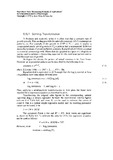| dc.contributor.author | Makridakis, Spyros | |
| dc.contributor.author | Wheelright, Steven | |
| dc.date.accessioned | 2015-12-16T15:09:24Z | |
| dc.date.available | 2015-12-16T15:09:24Z | |
| dc.date.issued | 1978 | |
| dc.identifier.isbn | 978-0471937708 | |
| dc.identifier.uri | http://hdl.handle.net/11728/6671 | |
| dc.description.abstract | In business and economic series it is often true that a constant rate of
growth prevails. This can happen with the sales of a company, GNP, consumption
patterns, etc. For example, if the growth in GNP is 5% a year, it implies a
compounded yearly rate of growth of 5%, a pattern that is exponential. Table 6-4
shows the revenues of an antipollution company (Lanard) which follows a typical
exponential pattern of growth. (These data are graphed in Figure 6-1.) Regression
can be used to estimate a forecasting equation for this nonlinear pattern and to
find the exact rate of growth. | en_UK |
| dc.language.iso | en | en_UK |
| dc.publisher | John Wiley & Sons Inc | en_UK |
| dc.rights | © 1978, Wiley, John & Sons | en_UK |
| dc.rights.uri | http://creativecommons.org/licenses/by-nc-nd/4.0/ | en_UK |
| dc.subject | Economic forecasting | en_UK |
| dc.subject | Business forecasting | en_UK |
| dc.subject | Semilog transformation | en_UK |
| dc.title | Semilog Transformation | en_UK |
| dc.title.alternative | Forecasting: Methods and Applications | en_UK |
| dc.type | Book chapter | en_UK |


